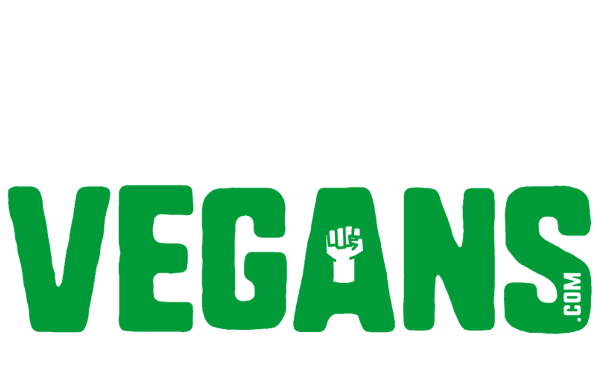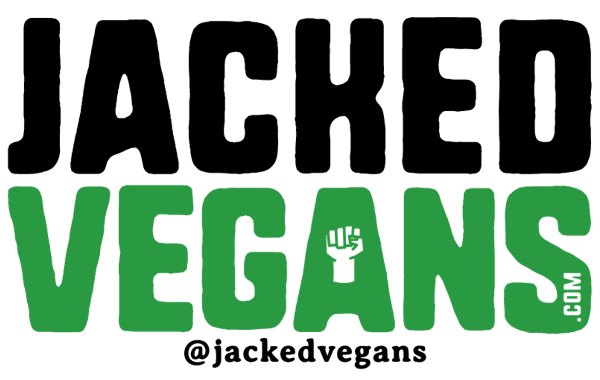Do you want to know how to gain weight as a vegan?
Many vegans struggle to pack on weight, and find that building muscle is difficult. This has many reasons, but they can all be solved with the right approach.
With the principles you’ll discover below, you’ll overcome your weight gain plateau and learn how vegans can gain weight and get jacked.
Let’s dive in
Why People Struggle with Weight Gain on a Vegan Diet
A lot of people transition to veganism and eat nothing but whole foods, which is awesome for good health.
But this can get problematic when you’re trying to gain weight because whole foods have lots of volume and few calories.
Eating lots of whole food won’t add many calories to your diet, and calories are the most important driver of weight gain.
If you want to gain weight and build muscle, you should focus on three principles::
- Consume enough calories to feed the growth of high energy demand tissue
- Consume enough protein to build and retain muscle tissue.
- Create stress on muscles through training to grow them.
We’ll break these principles down in detail later on, so you know EXACTLY what to do to gain weight. But first, let’s address the myths that circulate the internet about gaining weight on a vegan diet.
Busting Common Myths About Vegan Weight Gain
Can You Gain Weight on a Vegan Diet?
Many people think a vegan diet is only good for losing weight and you can’t gain weight on a vegan diet. This, of course, is ridiculous.
Gaining weight and muscle comes down to proper nutrition, proper training, and consistency.
You can gain weight on a vegan diet if you consume enough calories. And the vegan diet includes plenty of high-calorie foods and snacks to make this easier.
Does Veganism Cause Muscle Loss?
Veganism is not a cause for muscle loss. If you’re losing muscle as a vegan, it means you’re doing something wrong on the nutrition and/or training side of things.
Here’s a picture of my girlfriend (7 years vegan at this point), and me (1.5 years vegan at this point):
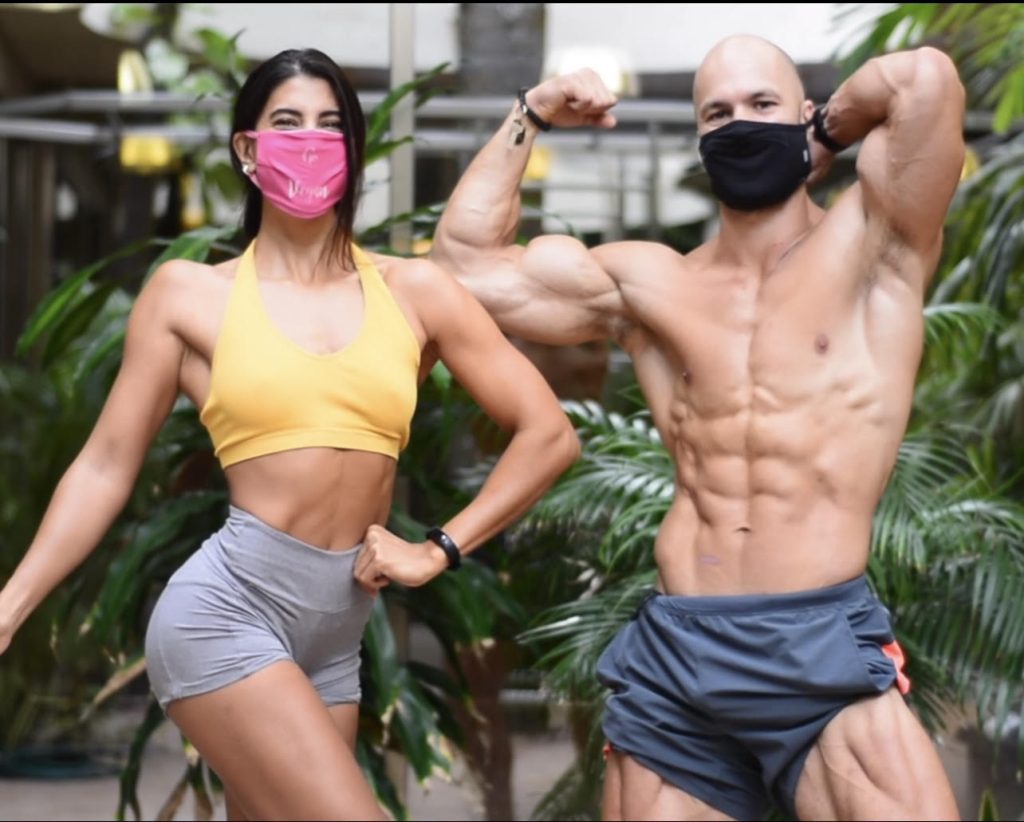
Does it look like we’ve lost muscle? No, in fact we’ve gained muscle.
Can You Get Enough Protein to Get Big on a Plant-Based Diet?
Many people believe you can’t get enough protein on a plant-based diet to build muscle and get big. But a vegan diet includes plenty of plant-based protein sources.
Where do you think non-carnivorous animals get their protein from?
From plants!
As a vegan, I consume around 200-220 grams of protein per day. You can find my 24 favorite protein sources here.
How to Gain Weight as a Vegan: 11 Tips for Quicker Gains
-
Consume More Calories Than You Burn
If you struggle to gain weight you’re not consuming enough calories.
You might feel like you eat A LOT, but if the scale is not moving up, that means you’re not eating enough.
And it all comes down to calorie balance.
Explaining Calorie Balance
Calories are the unit we use to measure the energy extracted from the nutrients in your food.
Your body burns calories to fuel your daily activities. Walking requires calories, thinking requires calories, digesting your food requires calories, even reading this text requires calories.
Calorie balance is the ratio between the number of calories you consume and the number of calories you burn.
You can have three states of calorie balance:
- Negative calorie balance (or Hypocaloric State): You consume fewer calories than you burn, creating an energy deficit. This always results in weight loss no matter what you eat.
- Calorie Balance (or Isocaloric State): You consume an equal amount of calories as you burn. The result is that you maintain your bodyweight.
- Positive Calorie Balance (or Hypercaloric State): You consume more calories than you burn, creating an energy surplus. This results in weight gain (and if you train properly, most of that weight will be muscle).
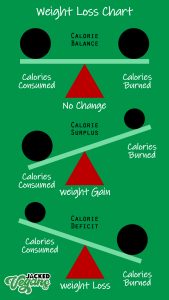
The first step to gaining weight is to calculate how many calories you need to put yourself in a calorie surplus.You can use our FREE vegan calorie and macro calculator to do so.
How to Track Your Calories
Tracking you calories removes ALL guesswork about what happens with your bodyweight.
When you track everything you eat — yes EVERYTHING — you’ll know what adjustments to make when you’re not meeting your weight gain goals. (We’ll cover this more later on.)
My favorite calorie tracking app is MyFitnessPal — you can scan labels and quickly add foods, then plan out your days in advance.
Take the numbers our calculator gave you, and put them into MyFitnessPal to track EVERYTHING you eat.
-
Eat Sufficient Protein To Fuel Muscle Growth
Protein is the key macronutrient when it comes to body composition and health. Consuming sufficient protein improves recovery, stimulates muscle growth, and makes you stronger. [1]
Your muscles are made out of protein, so you need to consume enough to either build more muscle or maintain the amount of muscle you have now.
Research suggests that around 0.7 grams–1.1 grams of protein for every pound of bodyweight is enough to cover your needs, and consuming more seems to have no additional benefit. [1] [2] [3]
-
Eat Calorie Dense Vegan Foods
Calorie density refers to the amount of calories a certain food contains per gram.
Calorie dense foods contain a large number of calories per serving, and tend to include high sugar, high fat foods.
This might not sound ideal, but these are “dream” foods for people who struggle to put on weight. Eating just a bit of these foods will add a TON of calories to your diet.
This image explains it:
- Nut butters
- Ice cream
- Donuts
- Vegan Nutella
- Daiya vegan pizzas (LOVE THEM)
- Cookies
- Protein Bars
- Weight Gainers
- Nuts and seeds
- Cereal
- Sport drinks
- Soy milk
- Coconut milk
- Processed Plant-Based Meats (beyond burger, impossible burger, orgain meats, etc)
- Dried fruits
- Plant-based protein waffles (with regular maple syrup).
- Protein Brownie
-
Use Shakes and Smoothies
You can pack over a thousand calories in a single smoothie, which makes them a favorite for weight gain.
Plus, they usually take less than 7 minutes to make.
Here are some of my favorite recipes:
And the cool thing is you can add more calories to these smoothies by adding peanut butter, oatmeal, almond butter, banana, etc.
Here are some measurements to make it easy for you:
- 1 tablespoon of peanut butter: 100 cals
- 100 grams dry oatmeal: 70 calories
- 1 tablespoon of almond butter: 100 cals
- 1 medium banana: 105 cals
4. Keep Vegan Snacks in Your Pockets
When you’re on the go, pack some vegan protein bars in your pockets, to have a quick calorie and protein source in your pocket when you need one.
Protein bars are better than other snacks because you’ll get a relatively high calorie meal with a good serving of protein. Plus, they’re not too filling and small enough to keep in your pocket, so you easily have one… or two :-).
Some of my favorite protein bars are:
Vega:
- 190 calories per bar
- 8 grams of fat
- 21 grams of carbs
- 10 grams of protein
- 290 calories per bar
- 10 grams of fat
- 26 grams of carbs
- 20 grams of protein
Garden of life chocolate fudge:
280 calories per bar
- 9 grams of fat
- 26 grams of carbs
- 20 grams of protein
5. Limit Cardio Exercises
Cardio burns calories! Our objective is to keep as many calories ON your body as possible, so doing cardio will make this MUCH more difficult.
However, you shouldn’t completely stop moving.Some level of cardiovascular activity is healthy for you, but you only really need somewhere between 7,000 – 14,000 steps per day.
This will be enough for most people to stay healthy.
6. Start Lifting Weights
Perhaps the most important asset humans have to traditional muscle growth is our ability to adapt!
If you ONLY stick to the recommendations above without adding resistance training, all you’d attain is an overly large gut..
But when you pair the nutrition strategies with resistance training, voila! You’ll pack on muscle and sculpt a hella sexy body!
You’ll also experience unexpected outcomes of enhanced self esteem, increased self efficacy, decreased stress, augmented performance and intensified productivity.
Best Practices:
- Consistency trumps EVERY aspect of the routine. A 3 days/week program you stick to is better than a 5-days/week program you only follow sporadically.
- You need to commit to stick to your schedule for 6-8 weeks. If you don’t see results then, you can move on to different forms of training (or hire us to help you #shamelessplug 🙂
Too often people give up after a few short weeks. Then they start again and stop again. You’ll never get results if you stay in this cycle.
Best Exercises for Weight Gain:
The optimal exercises for weight gain are compound movements. These exercises require multiple joints and add a ton of stress to your Central Nervous System. They enhance mobility, increase flexibility, improve strength, and decrease likelihood of chronic injury.
You should focus on these exercises::
- Chest/Triceps/Deltoids:
- Lats/Biceps/Posterior Deltoids:
- Quads/Butt:
-
- Squat
-
-
- Lunges
- Bulgarian Lunge
- Deadlift:
- Hamstrings/Abs:
Doing these compound movements will hit every single muscle group in your body and result in significant gains.
7. Get Enough Sleep
Contrary to popular belief, you don’t make your gains IN the gym!
Gains happen during recovery. If you want optimal results, you need a proper sleep schedule.
Setting up a sleep pattern will help TREMENDOUSLY with sleep quality and recovery, as well as provide optimal brain function and performance throughout your day.
Here’s what you should do:
- Set a certain bedtime for every night of the week
- Put your phone away an hour before said bedtime
- Don’t drink caffeine within six hours of your bedtime
- Make your room super dark for bed!
Bad sleeping habits have a huge negative impact on your weight and muscle gain. Make sure you get enough rest.
8. Take Supplements
Vegans should take certain supplements to make sure we’re healthy.
Here’s a list of recommended supplements for health, and for making greater gains in the gym.
Supplements Every Vegan Should Take:
- VIT B12: The RDA (Recommended Dietary Allowance) for Vit B12 is set at 2.4 mcg for adults, 2.6 for pregnant women, and 2.8 for lactating women.
- VIT D: The RDA for Vit D for children and adults is 600 IU per day. Pregnant or lactating women and elderly people should aim for 800 IU per day.
- CALCIUM: The RDA for calcium is around 1000 mg daily and a little bit higher at around 1200 mg per day for those that are 50 and above.
- IRON: The RDA for adult men is typically around 8 mg. This increases to 18 mg for adult women and 27 mg for pregnant women.
- ZINC: The RDA for zinc among vegans is around 8-11 mg for adults, 11-12 mg for pregnant women, and 12-13 mg for lactating women.
- OMEGA 3 FATTY ACIDS: ADD RDA INFO
Supplements That Will Help You Gain Weight As A Vegan
- Vegan protein powder: Helps increase muscle mass
- Creatine: Not essential, but may allow you to do more work in the gym which results in a better physique.
- Caffeine: Helps improve the quality of your workouts. (I take a double espresso 20 mins before workouts.)
9. Track Your Weight Gain (Change Diet If Needed)
How will you know if you’re making progress?
You need to know whether your starting diet makes you maintain your weight, lose weight, or gain weight.
You’ll need a bodyweight scale to track your bodyweight.
Here’s how:
Weigh yourself three times a week first thing in the morning — as soon as you get up from bed — and calculate a weekly average.
I recommend you weigh yourself on Mondays, Wednesdays, and Fridays as soon as you wake up, before using the restroom. Then, at the end of the week, average out the numbers.
After three weeks you’ll know if the diet makes you gain weight, lose weight, or maintain.
Here’s a spreadsheet you can copy to keep track of your bodyweight.
What Should You Do After the First Three Weeks?
Three things can happen after you run your diet for three weeks. You either lose weight, gain weight or maintain your weight.
Here’s what to do in each situation:
- If you lose weight: Add more calories. Start with 500 additional calories (of carbohydrates). Check again after three weeks to see if you lost, gained or maintained weight.
- If you maintain your weight: Add more calories. Start with 300 additional calories (of carbohydrates). Check again after two weeks to see if you lost, gained or maintained weight.
- If you gain weight: Stay with the diet until you stop gaining.
11. Include Maintenance Phases for Lasting Results
When you diet for muscle gain, you’ll also gain some fat. This is part of the process and you can’t avoid it. This is why you need to include breaks.
If you continue gaining weight indefinitely you might end up overweight with too much body fat — no bueno.
The recommended gain rate is around +5-10% of your total bodyweight for every phase where you actively try to gain weight. After that your body fat levels might get too high.
That’s when you go into a maintenance phase. This phase is designed to help your body get used to your new bodyweight and the new muscle tissue you’ve added..
You will not actively try to put more weight on, instead, you’ll reduce your calories back to maintenance levels (use our calculator here). You have to stay in calorie balance for at least 8-12 weeks.
A Vegan Weight Gain Meal Plan That Will Bulk You Up
As you already know, calories are the driver of weight gain, now I wish I could just give you a personalized meal plan, but everyone’s caloric needs will be different.
So in this section I’ll give you some high calorie meal ideas, and you can put them together to fit your individual calorie and macronutrient needs — which you already calculated with our jacked vegan calorie calculator.
High Calorie Vegan Recipes for Breakfast
Vegan Pancakes
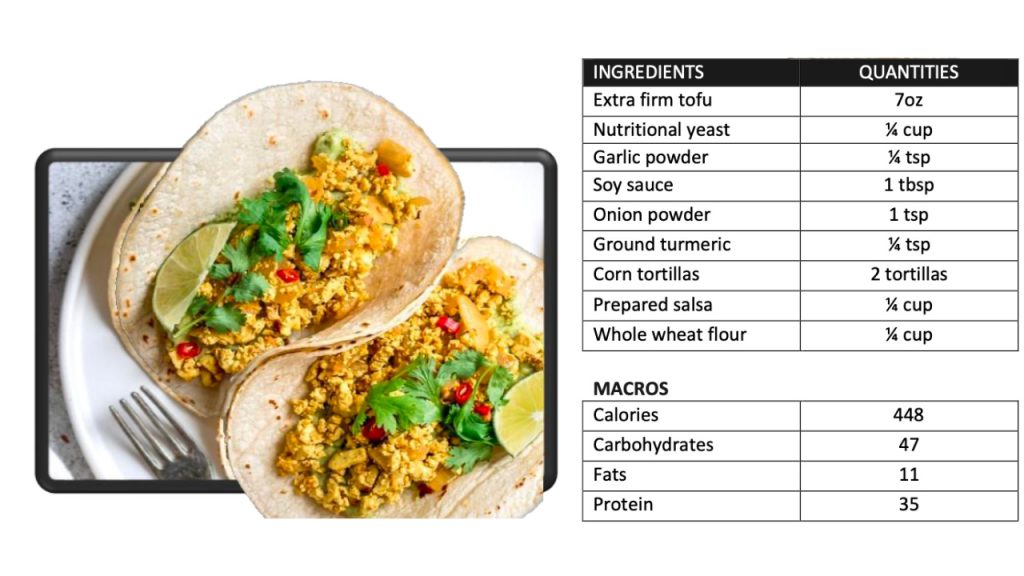
- Drain tofu and place the block on a plate.
- Cover with another plate and weight the top with a food can.
- Let stand for 20-30 minutes to extract excess liquid.
- Pour off liquid.
- Crumble tofu and place in a bowl.
- Sprinkle with flour, yeast, onion powder, garlic powder, turmeric and toss.
- Sprinkle soy sauce and toss again.
- Heat a large skillet or nonstick pan over medium heat until hot.
- Add tofu mixture and cook, stirring and scraping the bottom of the pan frequently to prevent sticking.
- Serve with tortillas and salsa.
High Calorie Vegan Recipes for Lunch & Dinner
Vegan Burritos
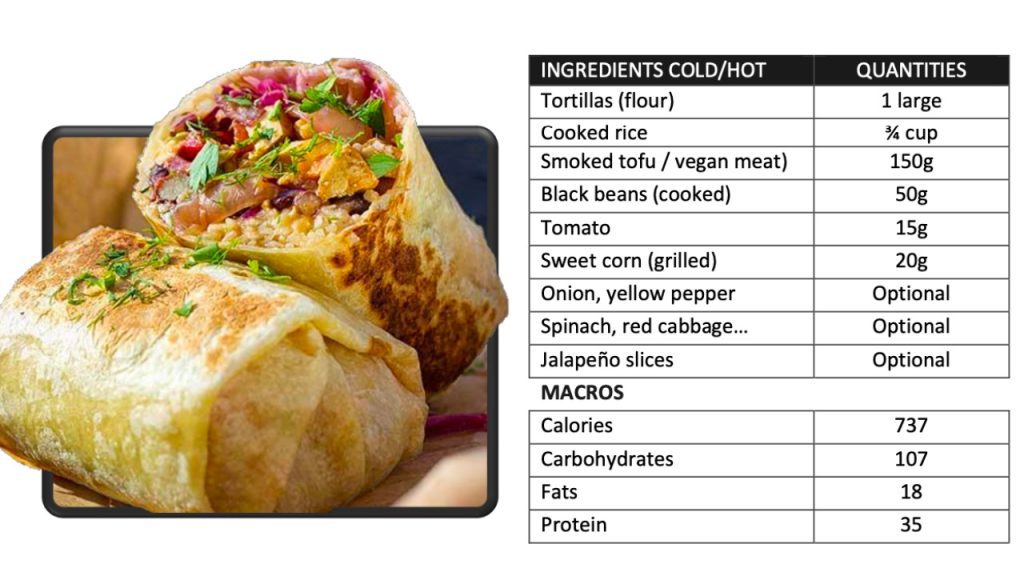
- Fill each tortilla with half of the cooked rice, smoked tofu (other vegan meat of your liking), salsa, beans, pickled onion and cabbage, corn, tomato, jalapeno slices, and bell pepper.
- Heat a pan over medium heat.
- Make the burrito by folding in the ends of the tortilla and roll into tight burritos closed on all sides.
- Place them side down into a frying pan and fry over medium heat for around 3-5 minutes until brown and crispy.
- Flip around and fry for another 3 minutes.
- Add some more salsa and chopped greens.
Vegan Pizza
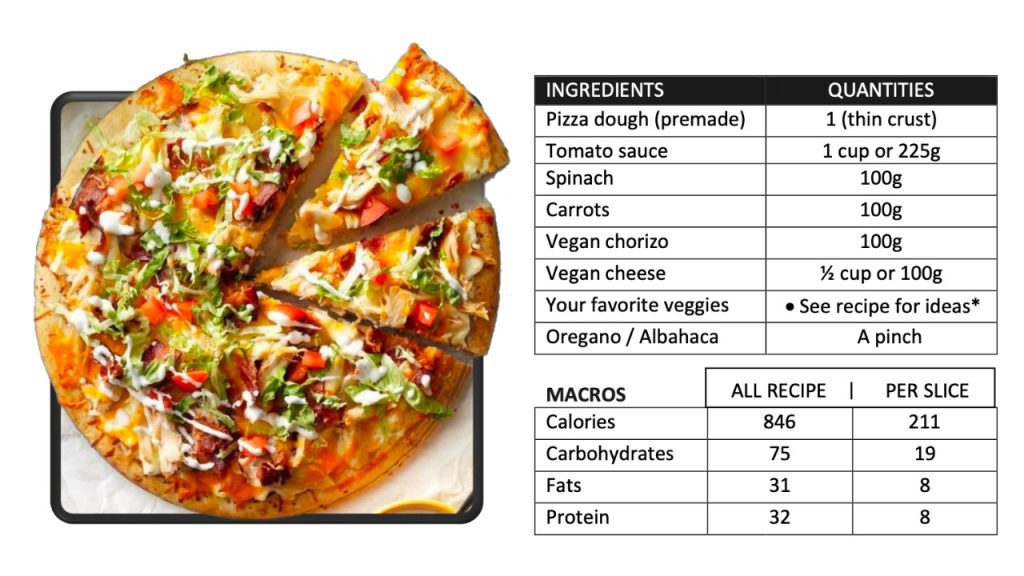
- Lay out your pizza dough.
- Pour the tomato sauce on the dough and spread it around evenly. Add the minced garlic on top of the sauce.
- Take a handful of chopped spinach and add a thin, even layer over the sauce. Do the same with the grated carrot.
- Add the veggies of your choice.
- Top off with a handful of vegan chorizo and a thin layer of vegan cheese.
- Bake for 20-25 min (the vegan cheese should melt and the crust will look golden brown).
High Calorie Vegan Desserts
Vegan Berry Ice Cream
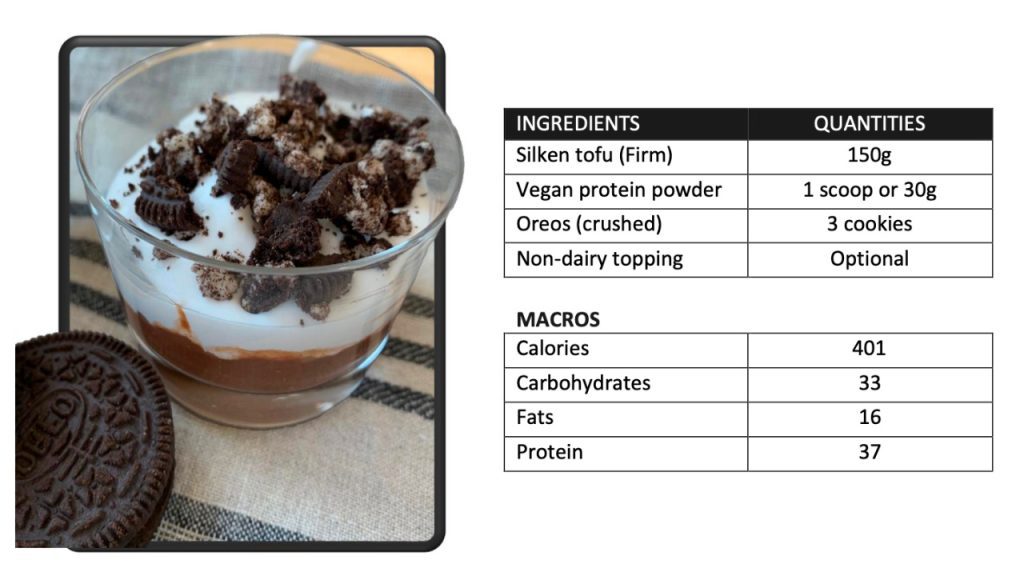
- Whisk tofu with protein powder until smooth.
- Layer in your parfait glass with crushed Oreos and another layer of the tofu and protein.
- Top with whipped topping (if using) … and enjoy!
The bottom line about gaining weight as a vegan?
Implement everything we discussed here and you’ll be well on your way to gaining weight as a vegan.
But you gotta understand something.
Having an amazing, greek god(ddess)-like body is a lifetime pursuit.
Use this article to get some wins, put on some quality pounds and kickstart your fitness journeys.
Picture what you would look like after years of consistency with nutrition and training.
Keep that picture in your head.
And if you want expert guidance throughout this process, you can book a free consultation with us here so we can help you with your fitness goals.
Now get after it!!!

